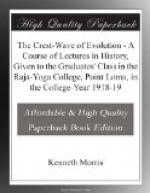Now cyclic impulses waste; a second day of splendor will commonly be found a Silver Age, where the first was Golden: it will often be more perfect and refined, but much less vigorous, than the first. So I should look for the second “day” of the Hans to come on the whole with less light to shine and less strength to endure than its predecessor; I should expect a gentleness as of late afternoon in place of the old noontide glory. But then there is the complication induced by Han Kwang-wuti, who started his cycle in 35.... or more probably his half-cycle;—I should look for it to be no more than that, on account of this same wastage of the forces;—this also has to be taken into consideration.
Brooding over the whole situation, I should foretell the history of this second Han Dynasty in this way: from 35 to 67,—the latter date the point where the old and new cycles intersect,— would be a static time: of consolidation rather than expansion; of the gathering of the wave, not of its outburst into any splendor of foam. Between 67 and 100, or when the two cycles coincide, I should look for great things and doings; for some echo or repetition of the glories of Han Wuti,—perhaps for a finishing and perfecting of his labors. From then on till 197 I should expect static, but weakening conditions: static mainly till 165, weakening rapidly after. Advise me, please, if this is clear.—Well, if you have followed so far, you have a basis for understanding what is to come.
The dynasty, as thus re-established by Kwang-wuti, is known as that of the Eastern Hans; for this reason:—just as late in the days of the Roman empire, Diocletian was stirred by cyclic flowing east-ward to move his capital from Rome to Nicomedia,— Constantine changed it afterwards to Byzantium,—so was Han Kwang-wuti to move his from Changan in Shensi, in the west, eastward to Loyang or Honanfu,—the old Chow capital,—in Honan.
While Rome was weltering under Caligula, Claudius, and Nero, China was recovering herself, getting used to a calm equanimity, under Haii Kwang-wuti: the conditions in the two were as opposite as the poles. She dwelt in quietness at home, and held her own, and a little more, on the frontiers. In 57, two years before Nero went mad and took the final plunge into infamy, Han Kwang-wuti died, and Han Mingti succeeded him. As Nero went down, Han Mingti went up. His ninth or tenth year, remember, was to be that of the recurrence of the old Han cycle. It was the year in which the provinces rose against Nero,—the lowest point of all in Rome. I do not know that it was marked by anything special in China; the fact being that all the Chinese sixties were momentous.




